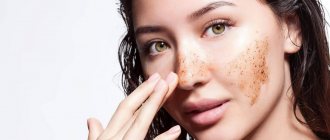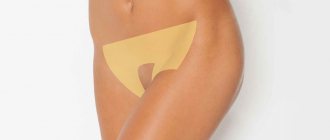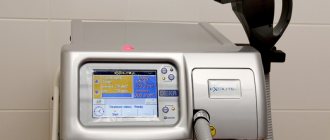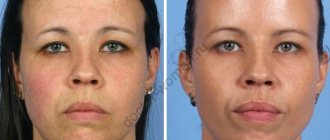Published: 11/01/2021 15:25:00 Updated: 11/01/2021
Acne is a chronic inflammatory skin disease caused by excessive sebum production and blockage of the sebaceous gland ducts. As a result of the accumulation of secretions, blackheads characteristic of acne appear.
In adolescents, acne is considered the most common skin disease, and in general it affects more than 65% of the population. Most often, the disease is observed on the skin of the face, representing not only a medical, but also a cosmetic problem.
Acne is not an independent disease, but a symptom of one or more disorders in the body. Without timely and appropriate treatment, severe skin lesions develop, which require complex therapy lasting several months and even years, as well as cosmetic procedures to eliminate cosmetic defects.
Causes of acne
The following main causes of the problem are known:
- hormonal disorders (adolescence, pregnancy, menstrual cycle phase, excess cortisol due to chronic stress);
- diseases of the gastrointestinal tract and thyroid gland;
- improper skin care or incorrectly selected cosmetics;
- taking certain medications (for example, anabolic steroids);
- genetic predisposition;
- skin damage accompanied by local inflammation;
- anatomical features of the skin (thickening of the stratum corneum, accumulation of epidermal particles in the pores, intensive proliferation of bacteria that cause inflammation);
- unhealthy diet and bad habits.
In infants, acne occurs in the first months of life due to excess levels of maternal hormones in the blood, which are transmitted in the last trimester of pregnancy or enter the baby's body during breastfeeding (stress hormone cortisol). Another common cause is considered to be dysfunction of the sebaceous glands during the formation of the baby’s hormonal levels.
What is LHE technology?
When talking about LHE, we are talking about exposure to broadband pulsed light. LHE therapy uses a special lamp containing inert gases, which allows you to work with light ranges of 600-900 nm (from green to IR). The green and yellow spectrum are able to reach the sebaceous gland; during the procedure, they are absorbed by the chromophore porphyrin.
During this chemical reaction, atomic oxygen is released, which causes peroxidation of the bacterial walls. IR radiation has an anti-inflammatory effect, helps pores open, improves microcirculation, and activates phagocytosis.
The course of LHE therapy lasts 1-2 months. As a rule, patients are prescribed 2 sessions per week, each lasting 20-30 minutes. The procedure does not require rehabilitation, so patients can not be interrupted from their daily activities.
Acne classification
There are several characteristic disorders of acne:
- Comedones: plugs that form in the pores and consist of sebum and epithelial cells. Open comedones form blackheads, and closed comedones form whiteheads.
- Papules: dense pimples without a purulent head, which are usually formed from closed comedones. When formed from a closed comedon, the opening of the hair follicle is noticeably expanded in the form of a dark plug.
- Pustules: pimple with purulent contents.
- Nodules and cysts: subcutaneous lumps filled with pus. Usually bluish-purple in color. They leave deep scars.
According to the severity, there are 4 degrees of the disease according to the classification of the American Academy of Dermatology:
- mild: comedones and single papules;
- moderate: multiple papules, single pustules;
- severe: multiple papules and pustules, single nodes;
- extremely severe: multiple nodes and cysts.
Newborn acne appears as tiny red bumps on the face or upper chest and back.
Acne-prone skin: care
Sensitive skin may react by developing acne if not properly cared for. Therefore, it is worth excluding products with fragrances, mineral oils, and alcohol (ethyl, ethanol, etc.) from your daily beauty routine. These ingredients can disrupt pH and harm the hydrolipid mantle.
Avoid perfumed cosmetics; they may contain phthalates as fragrances, which can affect hormonal levels. Vaseline and liquid paraffin can clog pores, causing acne.
If you develop rashes as a result of improper care or other reasons, you need to get rid of them correctly. One of the topical remedies against acne is Azelik® gel, which must be applied 2 times a day to cleansed skin5.
Useful ingredients for rashes include vitamin A, tea tree oil, lactic, salicylic, azelaic, glycolic acids, clay, sulfur.
Care for dry skin with acne
Acne usually appears on oily skin, but dry skin is not immune to inflammation. Constantly flaky and dehydrated epidermis is vulnerable to bacterial attack. You should not frequently use exfoliating agents, as they can damage the hydrolipidic mantle, destroying the protection against pathogenic microflora.
It is better to replace foamy cleansers with creamy ones. You can apply salicylic acid cream at night.
Care for oily, acne-prone skin
Oily skin with acne needs more thorough cleansing. Your care should include products with charcoal, salicylic acid, and tea tree oil. After washing your face, you can use clay masks once a week.
Don't neglect hydration. Maintaining the moisture balance of oily skin is extremely important. With a lack of moisture, the sebaceous glands will produce more secretion, which will worsen the course of acne.
Diagnosis of acne
The primary diagnosis is made after examining the patient by a dermatologist.
In appearance, acne-prone skin has a characteristic greasy sheen, enlarged pores, spots and various rashes. Problem areas for acne are usually the T-zone of the face (chin, nose and forehead), as well as the shoulders, upper back and chest, and less often the scalp. Since the causes of the problem are individual, patients are recommended to undergo a comprehensive examination, which includes a blood test (hormone levels: free testosterone, dehydroepiandrosterone sulfate, luteinizing hormone, follicle-stimulating hormone; glucose tolerance test) and consultation with other specialists to identify the underlying disease that caused acne (gastroenterologist, endocrinologist, gynecologist).
A genetic test is also performed to determine your predisposition to acne and a skin swab is taken to determine sensitivity to antibiotics.
Differential diagnosis is carried out to exclude other skin diseases (rosacea, secondary syphilis, perioral dermatitis).
How to treat acne vulgaris and which specialists should you be examined by?
In the presence of acne vulgaris*, treatment may be beyond the competence of a dermatologist if the causes of the disease are related to the malfunction of other organs and systems. A dermatologist may recommend consultations with the following specialists31:
- Gynecologist. Acne on the face of women after 30 may indicate polycystic disease, especially in the presence of anovulatory menstrual cycles and hirsutism.
- Endocrinologist. Pituitary adenoma and adrenal hyperplasia can be blamed for the appearance of acne. The endocrinologist checks the patient for the presence of thyroid pathologies and excludes carbohydrate metabolism disorders. If you have acne that is resistant to treatment, it makes sense to check for androgen-producing tumors. In women, for example, tumors of the ovaries and adrenal gland are excluded.
- Gastroenterologist. If acne is combined with rosacea (especially in men), you need to pay attention to the study of the gastrointestinal tract.
- Psychiatrist. Acnephobia is a real mental disorder in which a person scratches an existing or imaginary rash, injuring the skin and causing acne to worsen. Observation by a psychiatrist should take place in parallel with the main treatment of acne.
Acne treatment
Since dysfunction of the sebaceous glands at an early age is observed in the vast majority of people, serious treatment is usually not carried out until the age of 25 and is limited to regular visits to a dermatologist (monitoring the condition) and a cosmetologist (facial cleansing, peelings, skincare procedures).
If the problem persists or becomes serious, then complex therapy is selected for the patient. It is aimed at eliminating inflammation; reducing the number of bacteria on the surface of problem areas of the skin, reducing the formation of sebum and reducing the influence of hormones on the functioning of the sebaceous glands.
Drug treatment of acne can be local (creams, gels, ointments based on azelaic acid, benzoyl peroxide and other antibacterial drugs), as well as systemic, when drugs are prescribed for oral administration (antibiotics, hormonal drugs, drugs to combat the underlying disease). Usually these two approaches are combined. In addition, the specialist will select the optimal skin care using cosmetics.
Parents are concerned about how to get rid of acne in babies. As a rule, only regular and competent care is required for the baby’s skin; all rashes go away on their own and without consequences.
Particular attention should be paid to the diet for acne. If the problem is related to disorders in the gastrointestinal tract, the gastroenterologist will give appropriate nutritional recommendations. The general principles of diet therapy for skin problems require excluding from the diet sweets, flour and bakery products, fast food, alcoholic and carbonated drinks, coffee and strong tea, spices and sauces, fatty foods (smoked meats, fatty fish and meats), milk. Preference should be given to foods rich in vitamins C, A, E and B vitamins, antioxidants, selenium and zinc, omega acids, fiber (raw vegetables and fruits, nuts). Separately, we can highlight compliance with the drinking regime: water accelerates the elimination of toxins and wastes, which in acne slow down recovery or cause deterioration.
Modern approach to the treatment of age-related acne in women
Terminology and epidemiology
Acne is a polymorphic multifactorial disease of the hair follicles and sebaceous glands, resulting from overproduction of sebum, follicular hyperkeratosis, inflammation, lipid imbalance, some sex hormones and genetic predisposition, manifested by both the appearance of inflammatory elements (papules) and a violation of the skin texture, increased oiliness , hyperpigmentation, etc.
The most common form of acne is acne vulgaris (acne vulgaris). They develop in 80-90% of adolescents during puberty, when the adrenal glands begin to actively synthesize large amounts of androgens that stimulate the formation of sebum. In girls, the disease usually debuts at 12-14 years of age, in boys at 14-15 years of age due to their later puberty [1-7].
The manifestation of acne in older age groups is classified as late acne (acne tarda). In recent years, the number of women with late forms of acne has been growing. According to Colleir Ch. et al. [5], in adolescence, the incidence of acne is almost the same in both sexes, while acne tarda is much more common in women. Thus, according to various studies, the proportion of patients aged 25-40 years with acne is 40-54%. In studies conducted by Dummont-Wallon G. et al., Rosso J., Williams C. et al., the average age of women with acne was 31.8, 32.4 and 26.5 years, respectively. A multicenter study conducted in the United States between 1990 and 1999 found that the average age of acne patients increased from 26.5 to 40.5 years [1-7].
Etiology and pathogenesis
Studies have shown that the development and course of acne largely depends on family (genetic) predisposition, as well as on skin type, color and national characteristics. Acne is a disease with a high familial prevalence (50%). There is a general pattern: the more common and severe acne is in previous relatives, the more severe and torpid the course of the disease will be in the next generation.
Different expressivity and allelic variations of genes that determine the development of sebaceous glands, their functional ability and enzyme activity can play a large role in the development of the disease and largely determine the severity of skin manifestations. A number of researchers point to the presence of a nuclear R-factor that determines genetic predisposition. These facts, with a certain degree of probability, can explain the development of mild forms in some individuals, and severe forms of the disease in others. In a study by Pang Y. involving 238 patients with acne and 207 healthy individuals, it was found that short repeat length of the CAG gene and specific androgen receptor halotypes are associated with the risk of developing acne and, therefore, can be considered as a reliable marker of susceptibility to this skin lesion [ 9-12].
The skin is an endocrine organ, a “mirror” of the metabolism of sex steroid hormones, the action of which is carried out through specific androgen receptors. Androgens enhance the differentiation and mitotic activity of epidermal cells, free testosterone of ovarian origin, dehydroepiandrosterone and androstendinone of adrenal origin stimulate the secretion of sebum and the size of the sebaceous glands. Progesterone, which is a precursor to testosterone, estrogens and adrenocorticosteroids, has a similar effect. It also enhances the secretion of the sebaceous glands due to androgenic and antiestrogenic activity. Hormonal imbalance in patients with acne can be expressed as the androgen/estrogens ratio, where an increase in the production of the former and a decrease in the production of the latter corresponds to the clinical picture of acne. In this regard, on the eve of menstruation in healthy women, under the influence of progesterone, the secretion of sebum increases and inflammatory elements of acne appear.
Hypersecretion of sebum is a consequence not only of high levels of androgens, but also of increased sensitivity of the sebaceous glands to them. An increase in sebum production leads to a decrease in the concentration of linoleic acid, which is the trigger for pathological follicular hyperkeratosis; the latter, in turn, creates favorable conditions for the development of facultative anaerobes Propionibacterium acnes and Propionibacterium granulosum, as well as other representatives of saprophytic and opportunistic microflora (Staphylococcus epidermidis, S. aureus, Pityrosporum ovale) and the formation of comedones. In addition, the secretion of the sebaceous glands itself is a substrate for the proliferation of P. acnes. In this case, sebum is hydrolyzed by bacterial lipases to free fatty acids, which promote inflammation and the formation of comedones. Inflammation is also enhanced by P. acnes, which produces neutrophil chemotaxis factors.
Thus, acne is an androgen-dependent skin condition. Changes in the state of the gonads, pituitary gland, and adrenal glands determine the pathological secretion of androgen levels. In addition, it was noted that insulin enhances androgenization by stimulating the synthesis of luteinizing hormone from the pituitary gland in patients with polycystic ovary syndrome. In patients with acne, a slight but stable increase in insulin levels was observed.
Considering that the pathogenesis of acne is based on increased sebum secretion and certain immune processes, it is the state of immunity that attracts attention and is insufficiently studied. It was found that the total number of leukocytes, lymphocytes, CD20+, CD8+ cells does not differ from the control group, the content of CD3+ and CD4+ lymphocytes is below the control level. The level of cells with a marker of apoptosis (CD95+ lymphocytes) is significantly increased in patients, mainly with severe disease. With a slightly increased number of segmented cells, there is a sharp decrease in their phagocytic activity and intensity of phagocytosis, while the indicators of humoral immunity are not changed.
It must be remembered that in the small intestine, as well as throughout the large intestine, there are lymphatic follicles. An abundance of first-order lymph nodes adjacent to the mesentery, second-order, accompanying the aorta and vena cava, ascend along the esophagus and trachea into the thoracic lymphatic duct, then form a common collector, which serves as a regulator-cleaner. The body's T-cell immunity is directly related to the evacuation function of the intestine. The state of the intestinal microflora plays a certain role in this case. The most dramatic changes in the intestinal microflora are characteristic of all stages of acne. The data obtained indicate a significant change in the immune status of patients with acne.
Data indicating a relationship between stress factors and the occurrence of acne are quite contradictory. Thus, Goulden V. et al. found that only 12% of 71% of women in whom stress was the cause of acne, call it a provoking factor of the disease [17]. At the same time, Poli F., Dumont-Wallon G. et al. noted that stress is one of the significant factors provoking the occurrence of acne in women; it was identified as a trigger factor in 34-50% of cases [1, 7].
The link between stress and acne exacerbation is currently explained by the production of neurotransmitters (substance P), which influence the differentiation and division of sebocytes and stimulate the production of sebum. In turn, the skin of people with a tendency to acne is characterized by an abundance of nerve endings, an increased number of nerve fibers capable of secreting substance P, as well as a large number of mast cells.
Diagnosis of acne in women
Diagnosis of late acne should include both objective and additional examination methods (Table 1) [11].
Table 1. Examination of patients with acne
| Objective examination | History : onset, course of acne, reaction to previous treatment; gynecological and family history; attitude towards cosmetic defect; analysis according to the criteria of healthy puberty (stages and sequence of sexual development); taking oral contraceptives, acnegenic medications |
| General examination: assessment of secondary sexual characteristics, morphotype, degree of physical and sexual development; the nature of hair growth (hirsutism, hypertrichosis, androgenetic alopecia), the presence of skin signs of pubertal dyspituitarism (atrophic stretch marks, follicular hyperkeratosis, etc.); identification of the symptom complex of hyperandrogenic dermopathy | |
| Study of local dermatological status: type of acne elements, localization, severity, complications, post-acne, hyperseborrhea, seborrheic dermatitis | |
| Determination of facial skin type | |
| Differential diagnosis with demodicosis, rosacea, perioral dermatitis | |
| Additional Research | Laboratory studies of hormonal profile (total testosterone level, free testosterone, dihydroepiandrosterone sulfate, 17-alpha-hydroxyprogesterone, estradiol prolactin, cortisol, luteinizing hormone, follicle stimulating hormone, LH/FSH; sex hormone binding globulin; 5-α-reductase activity; steroid metabolites hormones in urine). ACTH test, dexamethasone test, glucose tolerance test, insulin, TSH, T3, T4 |
| Study of liver and kidney function (biochemical blood tests) | |
| Microbiological studies of skin scrapings to exclude demodicosis and gram-negative folliculitis | |
| Special methods of instrumental research (ultrasonography of the pelvic organs, mammography; radiography of the skull to exclude microadenomas of the pituitary gland, depressions in intracranial hypertension; EchoEG, REG, EEG | |
| Gynecological examination | |
| Consultations with an endocrinologist, gynecologist-endocrinologist |
Clinical picture
There are non-inflammatory and inflammatory clinical forms of acne. In the non-inflammatory form, closed or open comedones are determined, the precursors of which are microcomedones. Inflammatory elements are divided into superficial (papules and pustules) and deep (nodules, cysts, deep pustules).
The severity of acne varies: from superficial papulopustular elements that resolve without leaving a trace, to widespread deep nodular lesions that leave behind disfiguring scars. The severity of the process and the symmetry of the distribution of rashes allow us to assess the severity of the disease.
Unlike teenage acne, which is usually characterized by the prevalence of the pathological process, the predominance of moderate and severe forms of the disease, with late acne, the majority (70-80%) of patients are diagnosed with a comedonal and papulopustular form of the disease. The most severe manifestation of acne - acne conglobata - occurs in 15-20% of patients. The process is localized mainly in the face, less often in the upper third of the body. It should be noted that in patients with late forms of acne, in addition to acne, there are signs of skin dehydration due to previous drug treatment, irrational basic care, as well as background age-related changes in the skin.
Often, in patients with advanced acne, local or systemic use of antibiotics, as a rule, is ineffective: according to Rivera R. and Guerra A., 82% of women are resistant to antibiotic therapy [15]. Long-term torpid course and irrational treatment of the disease often lead to scarring and post-inflammatory hyperpigmentation.
We must not forget that acne belongs to a special group of skin diseases - psychosomatic dermatoses, during which the role of psycho-emotional disorders associated with the problem of “appearance defect” is great, which is especially pronounced in girls and women. Localization of pathological elements on open, visible areas of the skin brings deep psychological suffering to patients, reducing self-esteem, negatively affecting the quality of life, social status, professional activity, and personal relationships. According to some data, in the structure of the overall incidence of anxiety and depressive disorders, patients with acne occupy second place, ahead of many somatic and skin diseases, including oncological pathology. Patients with acne demonstrate higher levels of anxiety and depression compared to other dermatological patients: 30% of adolescents and 5% of adults with acne require active psychological and psychiatric care [8].
According to Tan JK et al., female gender, advanced age, and duration of the disease (more than 5 years) are additional factors that have a negative impact on the quality of life of patients, significantly reducing it [16]. Patients with acne are the most psychologically vulnerable; among them there is a large number (64%) of unemployed women with an unsettled personal life. Another study showed that in 40% of patients, a skin disease accompanied by a cosmetic defect leads to a decrease in their social status and negatively affects their professional activities.
Principles of treatment of late acne
Skin relief disorders that occur during a long torpid course of the disease and the hyperfunction of the sebaceous glands that patients already have require a balanced systematic approach using drugs that are safe for long-term use, which not only eliminate inflammatory elements, but also gradually eliminate other manifestations of acne. According to modern views, acne therapy should be carried out taking into account the prevalence and severity of the process, as well as the presence of changes in the hormonal and endocrine status of the woman. In addition, it is necessary to take into account the patient’s age, concomitant pathology, duration of the disease, and the effectiveness of previous therapy.
The main goals of acne treatment are:
• preventing the formation of comedones (preventive measures and tips for caring for “problem” skin); • removal of comedones (acne toilet, comedo extraction, tretinoin, retinoic acid, adapalene, salicylic acid, resorcinol); • reduction in sebum production (retinoids systemically and externally, hormonal drugs - antiandrogens, estrogens, etc.); • preventing the opening of comedones, pustules and the development of inflammation (antibacterial drugs for systemic and local use); • combination therapy (systemic antibiotics and topical retinoids or sequential use of glucocorticoids, systemic retinoids for severe forms of acne); • preventing the appearance of scars (early initiation of treatment, retinoids, eliminating the possibility of mechanical injury to acne elements); • improvement of the appearance of scars - only after achieving stable clinical remission (peeling, resurfacing, introduction of implants, corticosteroids; laser therapy, etc.).
For mild to moderate acne, which is characterized by the presence of non-inflammatory comedonal forms and superficial inflammatory papulopustular forms, mainly external therapy is required. In patients with severe acne (with severe dermal inflammation, purulent melting of the dermis), the prescription of combined oral contraceptives with an antiandrogenic effect in combination with topical anti-acne drugs, systemic antibiotics (for particularly severe forms) is indicated.
Systemic drugs that reduce sebum secretion include estrogens and androgens, which are prescribed to women when antibiotic therapy is ineffective. Systemic corticosteroids are used for adrenal hyperandrogenism. Treatment lasts 6-8 months. (until stable remission is achieved).
It is possible to use high-intensity blue light on acne elements and take zinc supplements, but the level of evidence for these types of therapy is low.
Antibacterial therapy is still relevant in cases of severe inflammation. P. acne is highly sensitive to antibiotics, but not all antibiotics are able to penetrate the follicles of the sebaceous glands. The most effective in this case are doxycycline, amoxicillin, and josamycin. In cases of severe suppurative processes with cystic forms, it is customary to prescribe combination therapy, including antibiotics, corticosteroids, as well as external use of antibacterial ointments containing benzoyl peroxide, clindamycin, lasting up to 2-4 months. External acne therapy should be long-term and carried out over several periods of epidermal renewal, which is due to the genetic nature of the disease.
An overview of recommendations for the treatment of acne in adult women is presented in Table 2.
Table 2. Recommendations for the treatment of acne in adult women
| Clinical characteristics | Recommendations for standard treatment | Recommendations for adjuvant therapy | Cosmetic recommendations |
| Hyperseborrhea | Gentle, soap-free cleansers with a pH similar to that of the skin Moisturizers* | ||
| Retention lesions/comedones on the lower part of the face and/or comedones on the forehead | Comedolytic drugs as monotherapy: • first line: topical retinoids • second line: topical azelaic acid § (15 or 20%) or benzoyl peroxide (2.5–5%) | No macrocomedones: • superficial chemical peeling For macrocomedones: • mechanical cosmetic procedures • physical extraction or light cauterization of macrocomedones | Gentle, soap-free cleansers with a pH similar to that of the skin. Moisturizers* |
| Inflammatory subtype: mild inflammation with papules | Monotherapy: • topical azelaic acid (15 or 20%) • benzoyl peroxide • topical retinoids | Superficial chemical peeling | Gentle, soap-free cleansers with a pH similar to that of the skin Moisturizers* |
| Inflammatory subtype: mild/moderate, papulopustules | Mild: • local combination therapy • topical retinoids and benzoyl peroxide (2.5–5%) • topical antibiotics and benzoyl peroxide (2.5–5%) or retinoids • topical retinoids and azelaic acid (15 or 20%) Second line : • Oral antiandrogens or oral contraceptives can be added to topical medications Moderate: • Systemic antibiotics, oral contraceptives, or spironolactone (50–100 mg/day) can be combined with any topical therapy | Superficial chemical peeling Photodynamic therapy | Gentle, soap-free cleansers with a pH similar to that of the skin Moisturizers* |
| Inflammatory subtype: severe papulopustular lesions | Severe: • first line : oral isotretinoin with cosmetics • second line: combination therapy (hormonal therapy with antibiotics and benzoyl peroxide 2.5–5%) | Steroid injection into lesions | Gentle, soap-free cleansers with a pH similar to that of the skin. Moisturizers* |
| Nodes | Systemic therapy: • oral isotretinoin • spironolactone (50–100 mg/day) or in combination with oral contraceptives or systemic antibiotics • oral contraceptives or in combination with oral antiandrogens or oral retinoids • systemic antibiotics Local treatment: • the same combined local remedies as for moderate acne; fixed combination of topical dapsone (5%) and benzoyl peroxide (2.5–5%) | ||
| Consequences of acne Post-inflammatory hyperpigmentation | First line: topical azelaic acid (15–20%) or retinoids, or retinoids/benzoyl peroxide Second line: hydroquinone or fixed triple combination (hydroquinone, retinoic acid and corticosteroids) | Superficial chemical peel Laser therapy or pulsed light for pigmentation Non-ablative fractional photothermolysis | UVA/UVB sunscreens daily* Use of cosmetics* |
| Scarring | Retinoids topically | Dermabrasion, chemical peeling Laser therapy Puncture excision/transplantation of deep scars Subcision and fillers Cryosurgery | Moisturizers* Using cosmetics* |
*All skin care products must be non-comedogenic and oil-free.
The need for non-comedogenic UVA/UVB sunscreens varies by geographic location. BPO – benzoyl peroxide; OK – oral contraceptives; PDT – photodynamic therapy; PIH – post-inflammatory hyperpigmentation.§ In the Russian Federation, the original preparation of azelaic acid is registered under the trade name Skinoren® The role of azelaic acid in the treatment of acne
In the process of searching for effective and safe drugs for the treatment of acne, researchers turned their attention to dicarboxylic azelaic acid, which was originally used to treat skin hyperpigmentation. The basis for this use of the drug was that with hypopigmentation caused by Pityrosporum, there is an increase in the production of C6–C12 dicarboxylic acids. In the 1970s Studies of azelaic acid have shown that it is effective in the treatment of hyperpigmentation and malignant melanoma without causing depigmentation in normal skin. It was later discovered that azelaic acid causes a therapeutic effect not only in hyperpigmentation, but also in the treatment of acne.
Main properties of azelaic acid:
• has an antibacterial effect on a number of aerobic and anaerobic microorganisms; • affects the final stages of epidermal keratinization; • in low (about 100 mM) concentrations it almost completely inhibits protein synthesis in P. acnes cells, exerting a bacteriostatic effect; • when the concentration increases to 500 mM, DNA and RNA synthesis is additionally inhibited and a bactericidal effect develops [13].
Under in vitro conditions, azelaic acid neutralizes the activity of reactive oxygen radicals (hydroxyl radical, superoxide anion radical), inhibits their production by neutrophils and can be considered as an antioxidant. In cell culture, azelaic acid has a weak effect or no effect at all on normal cells, but selectively penetrates into atypical cells of melanoma, carcinoma, lymphoma, exerting an antiproliferative and cytotoxic effect.
Despite the various pharmacotherapeutic properties of azelaic acid, it is mainly used to treat acne. This is due to its pronounced antibacterial, anti-inflammatory and antiproliferative effect, aimed at the main links in the pathogenesis of the disease in the absence of significant adverse reactions characteristic of other anti-acne drugs.
The original drug Skinoren® contains 150 mg of azelaic acid, micronized in 1 g of product, which is an advantage and distinguishes it from other products containing azelaic acid. It is a 1,7-heptane dicarboxylic acid HOOC-(CH2)7-COOH, which is an intermediate product of lipid metabolism and is not converted to any metabolites with obvious toxicity. Therefore, Skinoren® should be considered the safest of all anti-acne drugs.
Skinoren® normalizes the functioning of the sebaceous glands, hair follicles and the proliferation of P. acnes bacteria, which are constantly present on the skin, disrupted by acne. All these beneficial effects are achieved due to a local increase in the concentration of the natural product of lipid metabolism - the active principle of the drug azelaic acid.
The use of Skinoren® significantly reduces the number of inflamed and non-inflamed acne, and it acts not only on superficial papules, but also contributes to the disappearance of deep lesions - keloids and cysts.
The main indications for the use of Skinoren® are mild to moderate acne. For more severe forms, Skinoren® can be combined with antibiotics and isotretinoin, as well as with antiandrogen drugs. However, it should be borne in mind that since acne is not just an accumulation of inflammatory elements, but a disease of a complex nature, it responds slowly to any therapy. Thus, a clear clinical improvement is observed after 1 month. after starting to use Skinoren®, the main effects appear after 4 months, and the disappearance of deep lesions occurs after 5-6 months. Therefore, depending on the severity of acne, treatment with Skinoren® should be continued for a long time, for several months, until the maximum therapeutic effect is achieved [14].
As an additional therapy for acne, it is necessary to use medicinal cosmetics, which are an important component of the treatment program for patient management. When choosing cosmetics, it is necessary to take into account the patient’s skin type, data from hardware techniques that allow assessing the severity of oiliness, skin moisture and its pH.
In real practice, after stopping the inflammatory manifestations of acne, the attending physician often has to face difficulties in correcting post-acne, the most common manifestations of which are dyschromia and scars. To resolve dyschromia, superficial peels with α-hydroxy acids and medium peels with trichloroacetic acid (TCA) are successfully used. A good synergistic effect is achieved by the combined use of azelaic acid together with peels, as pre-peel preparation and post-peel care, especially in patients with dark skin, as a preventive measure hyperpigmentation and acne exacerbations. Visible results are provided by cryomassage courses (5-6 minutes 2-3 times a week, 10-15 procedures per course), mesotherapy, therapeutic massage courses (15 procedures) in combination with vitamin C electrophoresis.
To correct atrophic scars, chemical peels are used, most often median peels, microdermabrasion, laser resurfacing, filler injections, cryotherapy, and mesotherapy. The most effective are combined correction methods.
To treat hypertrophic scars, focal injection of corticosteroids, electrophoresis with corticosteroids, lidase, collagenase, beech therapy, phonophoresis with contractubex, madecassol, cryodestruction, ointment therapy, as well as surgical excision of scars with a large affected area are used.
conclusions
Thus, only a balanced, comprehensive therapeutic approach, taking into account all possible factors of the disease, provides a real opportunity to cure or alleviate the condition of patients with acne. The key to the success of therapy, especially for long-term, refractory acne, is the impact on the dermatological, hormonal-endocrine and psycho-emotional status of patients, which leads not only to lasting results, but also significantly improves the social adaptation and quality of life of patients. The use of azelaic acid opens up new possibilities in the treatment of acne, and also helps to increase the effectiveness and safety of local pharmacotherapy.
References 1. Dumont-Wallon G, Dreno B. Specificity of acne in women older than 25 years. Presse Med., 2008, 37: 585-591. 2. Williams C, Layton AM. Persistent acne in women: implications for the patient and for therapy. Am. J. Clin. Dermatol., 2006, 7: 281-290. 3. Del Rosso JQ, Bikowski J, Baum E. Prevalence of truncal acne vulgaris: a population study based on private practice experience. J. Am. Acad. Dermatol., 2007, 56: AB3. 4. Boathouse. D. Secrets of dermatology. St. Petersburg, 1999. P. 513. 5. Colleir Ch, Haper J, Cantell W. The prevalence of acne in adults 20 years and older. J. Am. Acad. Dermatol., 2008, 58: 56. 6. Samtsov A.V. Acne and acneiform dermatoses. M.: Utcom LLC, 2009. 7. Poli F, Dreno B, Verschoore M. An epidemiological study of acne in female adults: results of a survey conducted in France. J. Eur. Acad. Dermatol. Venereol., 2001, 15: 541-545. 8. Mayorova A.V., Shapovalov V.S., Akhtyamov S.N. Acne in the practice of a dermatocosmetologist. M.: “Clavel Firm”, 2005. 9. Masyukova S.A., Akhtyamov S.N. Acne: Problem and solution. Consilium Medicum, 2002, 4(5): 217-223. 10. Adaskevich V.L. Acne vulgar and pink. N. Novgorod: Publishing house NGMA, 2003. 11. Suvorova K.N., Kotova N.V. Severe forms of acne. International Medical Journal, 2000: 732-726. 12. Pang Y. et al. Combination of short CAG and GGN repeats in the androgen receptor gene is associated with acne rick in North East China, 2008. 13. Volkova E.N., Osipova N.K. Progressive technologies for managing patients with acne and post-acne. Ross. magazine leather and veins Bol., 2009, 5: 53-58. 14. Volkova E.N., Osipova N.K. External pathogenetic therapy for patients with acne and post-acne. Wedge. dermatol. and Venerol., 2010, 2: 72-77. 15. Rivera R, Guerra A. Management of acne in women over 25 years of age. Actas Dermosifiliogr., 2009, 100: 33-37. 16. Tan JK. et al. Divergence of demographic factors associated with clinical severity compared with quality of life impact in acne. J. Cutan. Med. Surg., 2008, 12 (5): 235-242. 17. Goulden V, Clark SM, Cunliffe WJ. Post-adolescent acne: a review of clinical features. Br J Dermatol 1997, 136: 66-70.
Consequences of acne and their elimination
Post-acne is a general name for cosmetic skin defects at the site of former foci of inflammation: scars, cicatrices, bumps, depressions, hyperpigmentation. Methods for eliminating these shortcomings are divided into:
- surgical: excision or laser destruction of scar tissue. Used for the formation of serious scars;
- non-surgical: pharmacological therapy (chemical peels with salicylic, lactic, trichloroacetic or azelaic acids), hardware treatment methods (laser resurfacing), injection treatment methods (plasma lifting, needling, mesotherapy, scar filling with preparations based on hyaluronic acid or collagen).
Acne pimples are not just a minor drawback, but a possible sign of a serious problem with serious consequences, so self-medication is unacceptable.
A timely visit to a specialist will help maintain healthy facial skin and prevent consequences, protect the patient from psychological trauma and improve his quality of life. Author:
Pugonina Tatyana Alekseevna, Therapist
Effect of the procedure: does LHE help if there are acne on the neck?
Immediately after the session, mild transient erythema may be observed. Rarely, acne may worsen after the first 2-3 sessions. This is due to the destruction of bacteria and the acceleration of the development of morphological elements. During the procedure, patients usually do not experience pain; sometimes a slight burning sensation is possible in the treated area.
You should not expect instant results from using the technique. The effect can be assessed by approximately 3-4 weeks of therapy.
If acne appears on the neck, other area of the body or face, LHE technology will not help as monotherapy. It must be combined with drug treatment prescribed by a doctor.
Myth 1. It is not necessary to visit a gynecologist as long as nothing hurts or bothers you
Unfortunately, this myth is very common among women of any age. Many believe that they themselves are able to determine by their self-feelings whether they have gynecological problems, and even if they arise, they try to take painkillers on their own or use some folk remedies that relieve unpleasant symptoms. However, this only drives the problem into a dead end, and when the woman does go to the doctor, she has to undergo long and serious treatment.
Follow us on Instagram!
Modern trends in medicine are aimed at preventing the development of chronic diseases as much as possible, immediately treating acute forms and thereby improving the quality of life of patients. Unfortunately, in our country this global trend is not yet taking root well; patients come to doctors already at those stages of the disease when serious measures have to be taken for treatment.
In gynecology, major health problems are not so difficult to prevent - you just need to visit a doctor once a year and undergo screening, which includes colposcopy, ultrasound of the pelvic organs, and examination of the mammary glands. If necessary, your doctor may recommend a thyroid examination and hormonal panel analysis.










